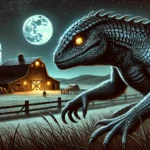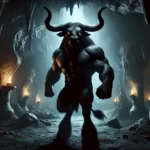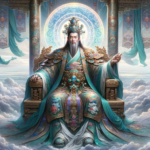Japanese folklore features a rich array of monsters and mythical creatures, each with unique stories and characteristics. This blog explores the top 10 Japanese monsters and myths, highlighting their origins, abilities, and narratives. From the shape-shifting Kitsune to the fearsome Yamata no Orochi, we delve into the legends of Tengu, Oni, Kappa, Yuki-onna, Jorōgumo, Rokurokubi, Nue, and the mysterious Gashadokuro.
1. Yamata no Orochi
Yamata no Orochi is a legendary eight-headed, eight-tailed serpent-dragon known for its enormous size and fearsome presence. Each of its heads can breathe fire, and its body spans eight valleys and hills. In the myth, Yamata no Orochi terrorized the land by demanding sacrifices. The monster’s fearsome reputation is solidified by its encounter with the storm god Susanoo, who cleverly intoxicates it with sake before slaying it with the Totsuka-no-Tsurugi sword.
2. Kappa
Kappa are water-dwelling creatures depicted as small, humanoid beings with webbed hands and feet, a beak-like mouth, and a dish-like depression on their heads filled with water. This water is their source of power. They inhabit rivers and ponds and are known for mischief, ranging from pranks to drowning people and animals. Kappa can be outwitted if a person bows to them, as they must return the gesture, spilling their water and rendering them powerless.
3. Tengu
Tengu are supernatural beings often depicted with both human and avian features. They typically have a red face, a long nose, and sometimes wings. Tengu are believed to reside in mountainous regions and are known for their martial prowess and knowledge of mystical arts. In many legends, they serve as protectors of sacred forests and temples, guarding these sites from intruders.
4. Oni
Oni are formidable creatures in Japanese folklore, often depicted as large, fearsome demons with sharp claws, wild hair, and horns protruding from their heads. They typically have red or blue skin and carry massive iron clubs, known as kanabō, symbolizing their brute strength. Historically, Oni are considered bringers of disaster, disease, and misfortune. In many stories, they inhabit remote mountains, caves, or abandoned fortresses, terrorizing humans who venture too close.
5. Kitsune
Kitsune are mythical foxes known for their intelligence and magical abilities. They can shape-shift into human form, often appearing as beautiful women to deceive and interact with humans. Kitsune possess numerous tails, with older and more powerful ones having up to nine tails. Their abilities include creating illusions, possessing humans, and generating fire or lightning.
Kitsune are often messengers of the Shinto deity Inari, acting as guardians of rice fields and agriculture. While some kitsune are benevolent, others are tricksters, using their powers to play pranks or seek revenge.
6. Yuki-onna
Yuki-onna is a spirit associated with snow and cold in Japanese folklore. She appears as a beautiful woman with pale skin, long black hair, and icy breath. Yuki-onna is often encountered during snowstorms, where she uses her chilling beauty to lure lost travelers.
Her abilities include manipulating ice and snow, freezing victims with her touch, and vanishing into mist or snowflakes. Yuki-onna can be both benevolent and malevolent; in some stories, she spares those who show kindness, while in others, she mercilessly drains the life from her victims.
7. Nue
The nue is a chimeric creature with the head of a monkey, the body of a tiger, the legs of a tanuki (raccoon dog), and the tail of a snake. Known for its eerie cry, the Nue is believed to bring misfortune and illness. In one famous legend, it terrorized the Emperor of Japan by appearing as a dark cloud over his palace, causing him to fall ill. The creature was eventually slain by the warrior Minamoto no Yorimasa, who shot it with an arrow. The Nue’s body was then discarded into the sea, symbolizing the removal of evil and misfortune.
8. Rokurokubi
Rokurokubi are supernatural beings with the ability to stretch their necks to great lengths, often while they sleep. By day, they appear as ordinary humans, usually women, blending seamlessly into society. At night, their necks elongate, allowing them to spy on or frighten unsuspecting people. Some Rokurokubi are depicted as benign, merely curious about human behavior, while others are more malicious, using their abilities to cause harm or mischief.
9. Gashadokuro
Gashadokuro is a giant skeleton monster formed from the bones of those who died from starvation or in battle without proper burial. It stands over 15 times the height of an average person and roams the countryside at night, seeking unwary travelers. Gashadokuro is nearly invisible in the dark and can silently approach its victims, capturing and biting off their heads to drink their blood. Its strengths are its enormous size, stealth, and terrifying appearance. However, it can be repelled by Shinto charms, rituals, or the sound of ringing bells, which warn of its approach.
10. Jorōgumo
Jorōgumo is a yokai with the ability to transform from a giant spider into a beautiful woman. This deceptive creature uses her alluring appearance to seduce unsuspecting men, luring them to her lair where she ensnares and devours them. Jorōgumo’s strength lies in her beauty and the strong silk webs she spins to trap her prey. Typically residing near water sources, she often poses as a helpless woman to attract victims.





